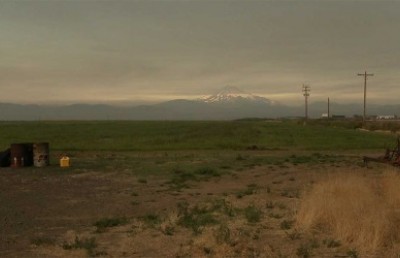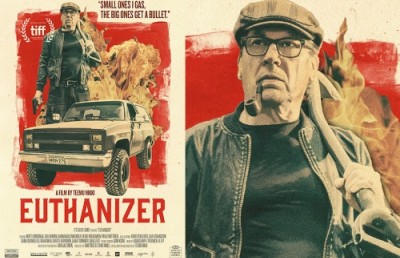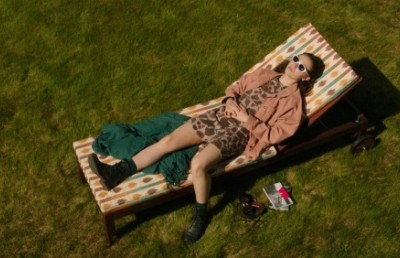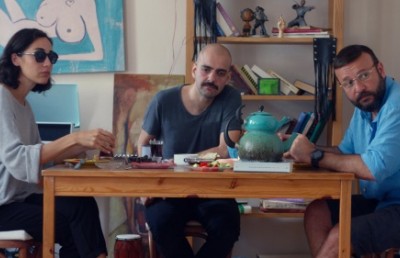RIDM 2018: An Interview with Kazuhiro Soda
Rencontres Internationales du Documentaire de Montréal
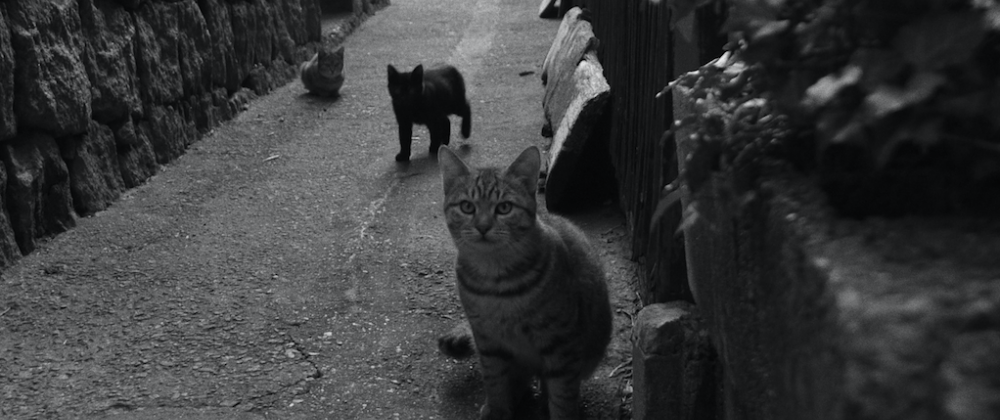
Montréal is once more adrift in a sea of documentary, and while the good folks at RIDM 1 do their best to guide us through this wave of newness that fills their festival catalogue, it can be comforting to find repose with a retrospective, to build oneself a little island within the schedule and form a relationship with a body of work. And this year the festival did not disappoint with two tremendous retrospectives from two filmmakers, who, in their own way are charting the political and social makeup of their respective countries. Brazilian filmmaker Maria Ramos dives right into the political and penal institutions of a changing Brazil, concluding with a chilling portrait of a dying democracy with this year’s The Trial. Coming at things more laterally, Japanese filmmaker Kazuhiro Soda trains his astute eyes on the margins, locating in ordinary people and small institutions compelling subjects and building, over a number of films, an intimate yet expansive portrait of Japanese society in its joys and challenges.
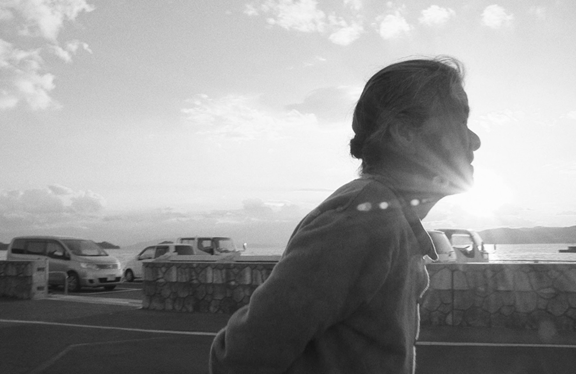
Inland Sea
More than just a gaze, Soda’s filmmaking is also a process, a way of thinking one’s relationship to the outside world, free of preconceived notions and formatted narratives. In his films, people and places grow as we watch them get shaded organically in ways both surprising and illuminating. One of the great pleasures and surprises of the festival was encountering a doctor who initially seemed endemic to Japan’s disinterest in mental illness, only to later learn of his selflessness and devotion to his patients. Soda explains before screenings his ten commandments, a series of rules he imposes on himself during filming. These are:
No research
No meeting with subjects
No scripts
Roll the camera yourself
Shoot for as long as possible
Cover small areas deeply
Do not set up a theme or a goal before editing
No narration, super-imposed titles or music
Use long takes
Pay for the production yourself
These commandments might seem prohibitive at first, but what emanates from Soda’s films is instead a sense of profound liberty, even if he often films subjects straining against their own set of regimented rules. Take, for example, Campaign (2007), Soda’s first documentary, which follows Yamauchi, a friend of Soda’s parachuted into a local election by the ruling party and given the full crushing support of its political machine. The film is almost gleefully apolitical, focusing on the process of politics, which in Japan mainly involves shaking hands at subway stations and never mentioning any form of policy or idea. What builds over the course of the film is more than only a portrait of a deeply apathetic political system, but a pointed treatise on the way society and institutions regulate bodies. Yamauchi, a loveable klutz with a nasally voice and a deer-in-the-headlights expression, is moved about, told to bow a certain way repeatedly, to shake hands like this, to stand there and smile. By the end of the film and the grueling campaign, Yamauchi and his wife appear more like ghosts than victors, their gaunt faces explaining better than any speeches the ways in which society bends and breaks people to its will. It’s no surprise that his next film would focus on mental patients, which in Japan are even more cast aside, left to be cared for by dedicated but under-funded non-governmental clinics.
These themes and discourses emerge from the films, but they do so naturally, politics emanating from their milieu like the migrant workers of Oyster Factory (2015) or the lack of governmental help for the needy shown in Peace (2010) and Mental (2008). Soda understands that it is by looking with empathy that one has any chance to get at the truth of things, and that the observant eye has to engage with the realities it sees in order to understand and transmit them.
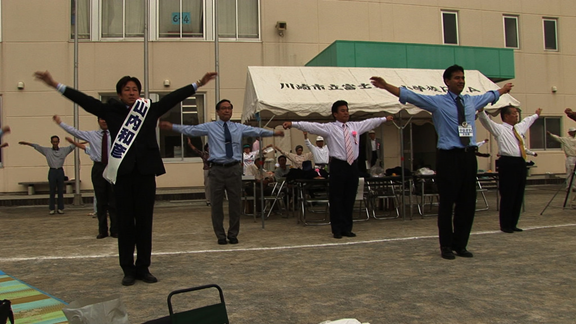
Campaign
Soda would return to the idea of regimented bodies in a two-part portrait of celebrated Japanese playwright Oriza Hirata, whose style blends naturalistic language with precise, minute calibration of performer’s movements (in the second film he experiments with making a play with robots, which seems like a natural extension of his working method). The films, Theatre 1 and Theatre 2 (both 2012), which run over two parts totaling more than five hours, offer a complex vision of the artist as leader and teacher, splitting their time between rehearsals, with Hirata hunched over in a corner constantly micro-managing (sometimes to humorous ends, as when he and his troupe plan a birthday surprise), and conferences and workshops where Hirata tries to communicate the joys of theater, language, and creation to students and teachers. In this way, we come to understand the roles and challenges of the artist within society, and the risks and minutiae of running a small theatrical company. Through all this, Soda’s vivid observational eye and total freedom – one never feels he chooses a shot or a composition in service of a larger point, but as a reaction to the moment he is experiencing – sees him moving freely among actors, social gatherings and workshops. The effect, as in Campaign, is exhilarating, but also strangely paradoxical, with “we” as the viewer moving freely among actors and politicians trained to execute the same movements. But Soda is too empathetic to lord over his freedom over his subjects, so the effect is more akin to one of constant discovery, an endless curiosity and surprise in interacting with the world.
It’s this free flowing sense of discovery that is most impressive and laudable in Soda’s filmic work. His best films, like Peace and this year’s moving, crepuscular Inland Sea (2018), place us in the shoes of the director, discovering alongside him the places and people that populate the margins of society. Inland Sea in particular, made after being turned away from the oyster factory of 2015’s aptly titled Oyster Factory, finds the director wandering the streets of the small fishing town of Ushimado, his camera guiding him along the streets of this fading place. It becomes an almost abstract portrait of the sounds and images of the town, guided along by two diametrically opposed figures: a stoic elderly fishermen whose silent boating scenes radiate with the serene force of a dying tradition, an entire world being gently ushered offscreen, and a stout, sinewy, elderly woman, a motor-mouthed force of nature whose logorrhea introduces us to the history and gossip of the town; she is a tragic figure also bound to be forgotten, but raging as the night slowly falls. Soda structures the film along his travels, so an early morning fishing trip turns into a fish auction, which leads to a fish store. Naturally we follow a pair of clients (a daughter and son who feed the stray cats of Ushimado) and then a passer-by who we will meet again up the hill. This gentle pace, which is modulated between films (Campaign takes place over a month, Inland Sea over a few days), lends a naturalistic, unrushed air to the proceedings. Soda’s is not a cinema that demands, but, as he himself terms it, one of observation. It is this sense of life happening as it is being observed that lends the film and Soda’s oeuvre its poignancy, its feeling of life being captured because it is worthy, not to serve a point decided a priori.
I met up with a smiling Soda on a freezing November morning and we discussed his approach to cinema, how his films relate to Japanese cuisine, and his concerns about the political situation of his country.
OFFSCREEN: To start, you call your films observational films. What do you mean by that?
KAZUHIRO SODA (KS): When I say observation, it doesn’t mean being a distant third party. It means looking and listening. The reason why I use the word observation is not only because I owe a lot to the traditions of observational cinema, but also I think looking and listening is very important for documentary filmmaking. And when you say looking and listening, there are two levels. One is I, as a filmmaker, look and listen carefully and then make a film based on my discoveries. That’s one level. Another level is I want the audience to look and listen carefully to what is happening in the film and make their own interpretation.
OS: Can you tell us a bit about your working methods, you often talk about your ten commandments?
KS: So how do I achieve such films? I came up with ten commandments that are my own rules. Basically, these ten commandments are for me to minimize my preconceptions and be open to whatever happens in front me and try to learn from it, and that’s the purpose of these commandments. I also want the audience to do the same. I want them to be open to many possibilities and try to look at the film in an attentive way.
OS: I’d like to talk about politics in your work. We have Campaign and Campaign 2 (2013), which are obviously about politics, but they seem like non-political political films. And what I find very interesting in your films is that politics seem to emanate naturally from them.
KS: Well, I’m not looking for it. If I’m looking for it, it’s not very observational. So I try not to have an agenda, but it’s also true that nobody can escape politics as long as you live in human society. Even buying chocolate in a supermarket involves politics or you can’t buy chocolate without being caught up in politics, international politics. In that sense, everything I see has a political aspect and I’m aware of it, so sometimes I focus on it. That’s why a film about theater which doesn’t look like a political subject could have politics in it and an oyster factory seems non-political in nature, but actually, if you look closely enough, you see politics, and I think that’s because of the nature of human society. We cannot live without politics.
OS: How did you develop your observational approach, especially compared to the more abrasive tradition of Japanese documentary of filmmakers like Kazuo Hara and Noriaki Tsuchimoto?
KS: I think in my case it was a reaction to TV documentaries. I used to make TV documentaries for about seven years, from 1997 until 2004, and while doing that I was always required to do lots of research before shooting and write up a pretty detailed script. It has a beginning, middle and end and even a shot list. You know how to end the film before you shoot and I didn’t really like it because you’re kind of locked up in your planning and perception, and it’s very hard to learn something new. Also, I didn’t really like the style of TV in terms of over explanation. They require me to explain everything with narration, music, or super-imposed titles and I was totally fed up with it. I also wasn’t particularly a big fan of activists films either like, for example, Michael Moore. He is a great filmmaker, but his films are often setting up his own agenda first and then finding material to support it. Fahrenheit 9/11 was only made because he wanted to defeat George W. Bush, and although I respect him as a filmmaker, I wanted to get far away from such films with a set agenda because I think the world is much more complicated, and that complexity interests me.
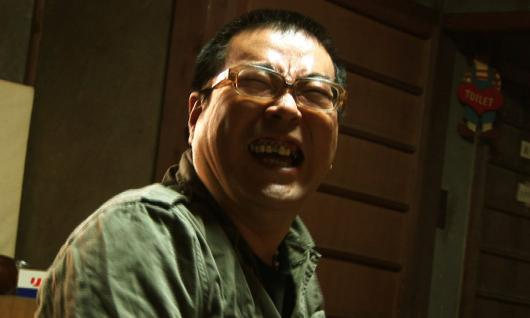
Mental
OS: Throughout your work, especially in Campaign and Mental, there is this interesting theme of body and society, how society bends people and bodies to its needs. What interests you in this relationship?
KS: Well, it’s interesting that you mention Campaign and Mental, because for me those films are like a before and after. Many people in Japanese society are expected to behave in a certain way and that’s shown in Campaign. It shows the relationship between society and the individual and the individual is basically losing individuality by living in society. But at one point you cannot go on forever like that and some people become sick because of that. I realized while making Mental that many people used to be at the centre of society like Yama-san. And because of that they become ill. So people in Mental, they are at the edge of society. They are pushed towards the edge of society, but at the same time they are more free compared to Yama-san in Campaign.
OS: I’m interested in your relationship to your subjects. For example, in Theater, the actors are stuck rehearsing and doing the same movements over and over again, while you move freely around the room. It makes your observational approach seem completely free.
KS: That’s an interesting point. Because I have ten commandments, many people misinterpret, think I am not a free filmmaker. I self-impose my rules and I’m kind of restricted, but actually, these restrictions are there to set me free, so that’s a contradiction that many people don’t catch.
OS: Did you have to change your working style when working on Mental or question yourself more about the ethical problems of filming people struggling with mental illness?
KS: Ethical problems. Well, actually when I started filming, I didn’t know about the subject very well. I was much more casual, excited to film. Then I realized the social stigma these people have is so enormous, so that increases my responsibility as a filmmaker towards the image of my subjects. So gradually I became very, very careful and concerned about my ethical responsibility in the course of making Mental.
OS: You never try to hide your presence behind camera. For example, there are often scenes where children come up to the camera. Why this choice?
KS: Actually, first I was fascinated in my early career by the films of Frederick Wiseman, and he never appeared behind the camera. And with Campaign, I tried to be like Wiseman, tried to be invisible and I was pretty much able to do it. But then when I shot Mental, people with mental illness, they didn’t really . . . they kind of acknowledge and talk to me while I was holding the camera even though I asked them not to, and they kept doing that. At first, I was kind of concerned because what’s happening is interesting, but I might not be able to use it. That’s how I felt when I was shooting. For example, Sugano-san, the poet, kept saying “Cut! Cut!” And it was funny. That scene alone, when I was shooting I thought: “What’s happening is really funny,” but at the same time I didn’t know if I could use it. But then when I was editing, I realized these scenes were very strong and important for the film. And if you cannot use strong scenes because of your own policy, I think that policy is wrong because you are trying to make a good film, a strong film, and if your policy ruins the strength of the scene, then your policy is wrong. So I adjusted my philosophy about observation. I realized observation has to be participant observation, meaning I have to observe the world, which includes myself. I’m there with my camera and of course it affects the people, and then that shows up in the film, and that’s okay. When editing Mental, I changed my policy or concept of observation
OS: You often use cutaways, “pillow shots.” Is that a way to remind us of the outside world, a nod to Ozu?
KS: That’s one function, definitely. I like to put my characters in the context. Which is quite natural, it happens naturally. Usually, I follow around my main characters and while following them, I feel like I’m looking at them with a magnifying glass. And then after a while I feel some desire to film something broader. I like to use a wide angle to see what I’m looking at, so I often, when I feel that way, I go out to the street with a tripod and look for shots that might be good for the film. And oftentimes, I’m watching affects the way I see the streets too, so these pillow shots usually have something to do with the main story too, and my hope is to have some kind of chemical reactions between those pillow shots and the main story, which could happen in the audience’s mind.
OS: There’s that feeling of taking a walk to decompress. It lets us think.
KS: Yes, it’s also another function. A human being cannot process information continuously too much, so it’s good to have sort of a moment when you let go. In Japanese cuisine we call it hashiyasume. You have the main dish, but in addition to the main dish you have side dishes. Hashiyasume is like the rest of the chopsticks.
OS: With Inland Sea, you decided to use black and white, which some would see as aestheticizing, adding a comment. Was that your intention?
KS: Actually, we shot everything in colour and I even edited the film in colour and it was a last moment accident. I even did the colour grading in colour, and I thought I was finished. I even thought the colour was the most important element of this film, especially the colour of twilights, because many important scenes happen in twilights and also it’s about the twilight days of old people and of a town. So I worked very hard to get the right tone for the twilights in colour. I even had a temporary title, Inland Sea in Twilight. But then I didn’t like that title, so I spoke with my wife and producer Kyoko and all of a sudden she suggested to me: “Why don’t you turn everything in black and white?” And I said: “Weren’t you listening to me? I said colour was the most important part of the film.” But then it was Midnight and I just wanted to see how it looks and I said what the hell, just try it. I turned everything in black and white, just one button and I started watching and I thought it made the film. And I redid the colour grading for black and white. But I think it adds a layer, it adds a feeling, like a timeless feeling. It feels like it could be 200 years ago or 200 years from now. It almost feels like fictional time. I think it fits to what I tried to depict or what I felt in Ushimago so, yeah, I went for it.
OS: It does have this feeling like they’re out of time or outside of progress and society.
KS: Yeah, you slip into this kind of spot which is somewhere beyond this world. It’s kind of like a timeline, if this is the world we live in it’s kind of out there, this feeling of a trip.
OS: Apart from your early fiction films, you’ve concentrated mainly on Japan. What drew you to the States for The Big House (2018)?
KS: You know, almost all the films I made is because I don’t really choose subjects. I just encounter by accident, and The Big House is no exception. I didn’t know anything about the Big House, but I was invited to teach for one year as a visiting professor. I was invited by Marcus Nornes, a scholar of documentary, and he studied Shinsuke Ogawa and he wanted to invite me for one year and he had the ambition to make a documentary about the Big House and he had this crazy idea to make a documentary about it using a class. So that’s why I said okay. So I didn’t know anything about the place, but the fact that it can house 100,000 people in one place, the biggest stadium in the States, and it’s for college football, not even professional, and every time they have a game they sell out. And that mere fact was quite intriguing to me. I was sure that if we do the project properly, we’d have a pretty compelling film.
OS: You have two series of films, Campaign 1 and 2 and Theater 1 and 2, that both follow an individual closely in the first film only to widen out in the second one. Was that a conscious decision?
KS: Yeah. It came naturally, maybe that’s the way I kind of think. It’s interesting you mention that. I’ve never thought about that, but that’s true, that’s usually the process. I usually look at the small world first and then I want to put them in the social context, the broader context. So maybe that’s why.
OS: Your films focus a lot on older people and forgotten people, people on the margins. I’m wondering, how do you see Japan right now?
KS: Politically speaking, Japan is on the verge of abandoning democracy. I’m very concerned about this. Abe Shinzo and his party took the power in December 2012, and since then he’s been dismantling democratic institutions and systems one by one, step by step. And because each step is kind of disguised as some sort of act, not many people are aware of the fact that he’s really dismantling democracy. So many people still vote for him and his party, and he’s been winning national elections. Now he has two thirds of the majority in both parliaments. And he’s so powerful that nobody can stop him anymore and he just extended his term. He was not supposed to run for a third time because of the rules of the NDP, but he changed it and he won. And I’m very concerned about the future of Japan, politically speaking. Socially speaking, we’re in the process of almost going to the bottom, I think. For the past 20, 25 years, Japan’s economy is so stagnant and also the population is declining. If you go to rural areas, you see so many stores closed, including my hometown. Every time I go back it’s heartbreaking. You see so many stores I used to go that are shut down, nobody takes over anymore. It’s called “shutter street.” Because so many stores are just closed.
OS: It’s like ghost streets.
KS: Yeah, and it’s everywhere, not just my hometown. And of course Ushimado is like that. Ushimado is actually past it, it’s on the verge of disappearing. It’s happening everywhere, so I don’t know what to expect. It’s sad to see my country going that way. I’m sure once it gets to the bottom, we’ll have a new situation, but it will be a lot of pain.
OS: What are your thoughts on Japan and immigration?
KS: I think right now, as we are speaking, the parliament is trying to pass this law to get more foreign labourers, although they don’t call it foreign labourers. And I’m not opposed to opening up to foreign labourers or accepting people who want to work and live in Japan. Actually, I’m for it. But the way they are thinking of it right now, they don’t even think of them as labourers, they consider them slaves. That’s not right. So, if we accept labourers, they should have access to the social welfare system, they should be treated the same as the Japanese, they should get to stay if they want to. They have to be treated as human beings. So I’m concerned about the policy they are doing. They are making a big mistake.
OS: Do you think Japanese people are too apathetic towards politics?
KS: I think so, just like what’s happening in the US or many developed countries. I think many people are apathetic or indifferent towards politics, thinking it has nothing to do with their daily lives. Actually, they are deadly wrong. What we enjoy every day is the fruit of politics, so it can be taken away anytime if you don’t care. So, Japan is not an exception, it’s part of a global phenomenon, or a global sickness from which we are suffering right now.
Featured Image from Inland Sea
Notes
- Rencontres Internationales du Documentaire de Montréal, or Montreal International Documentary Festival ↩


